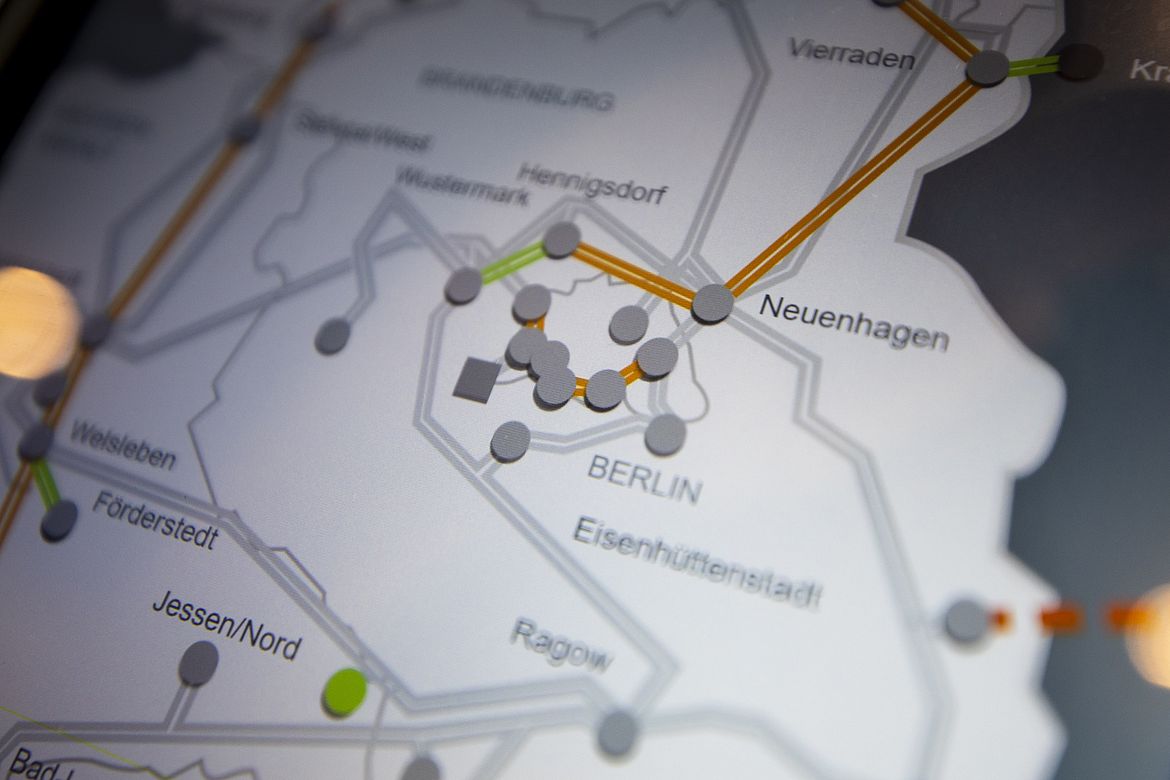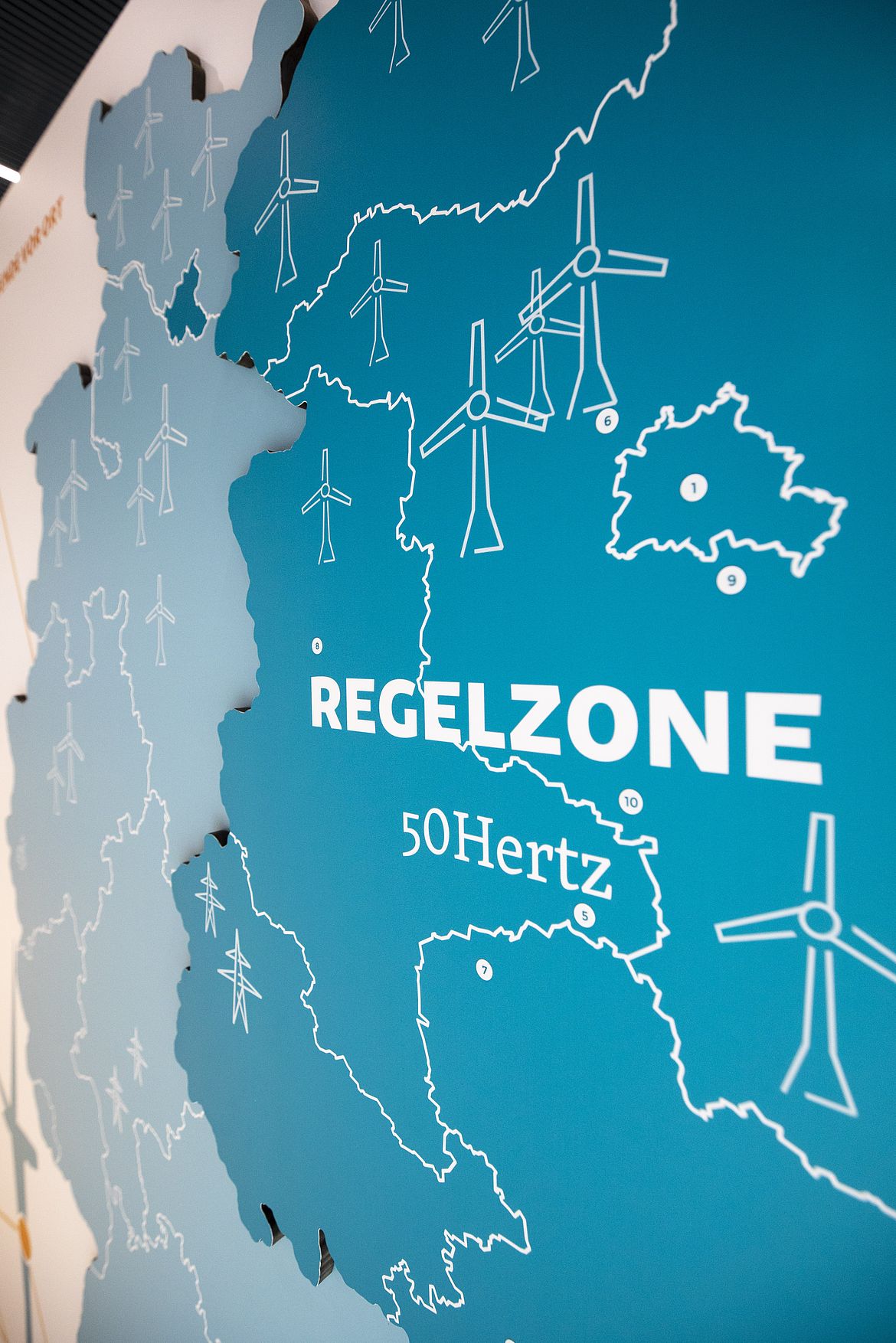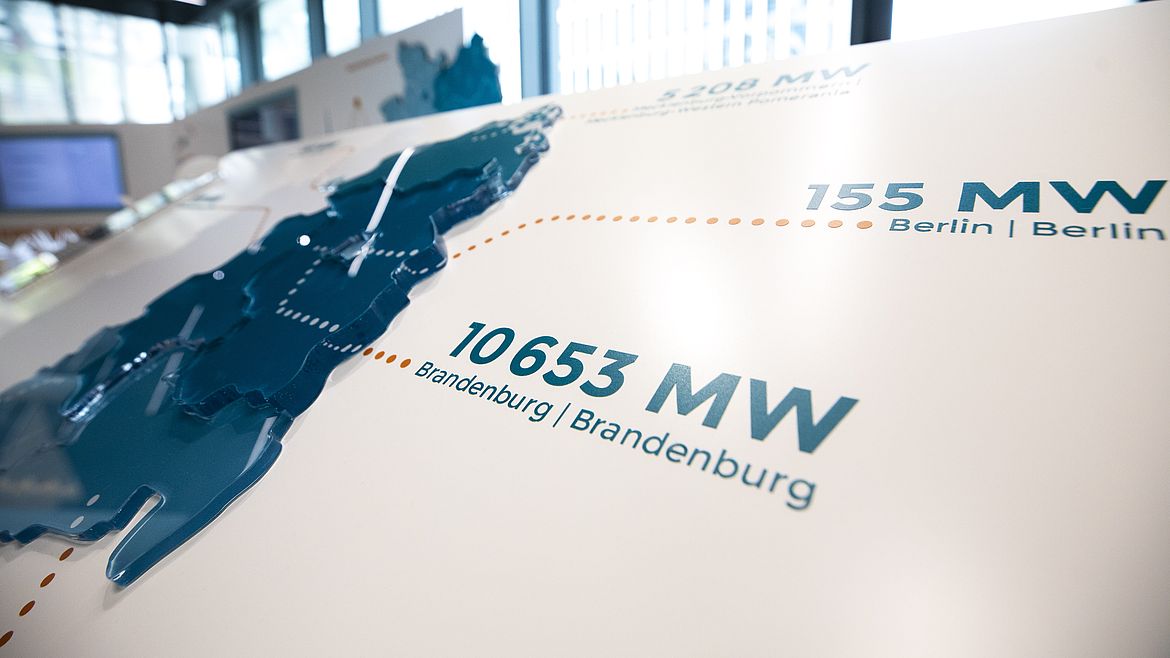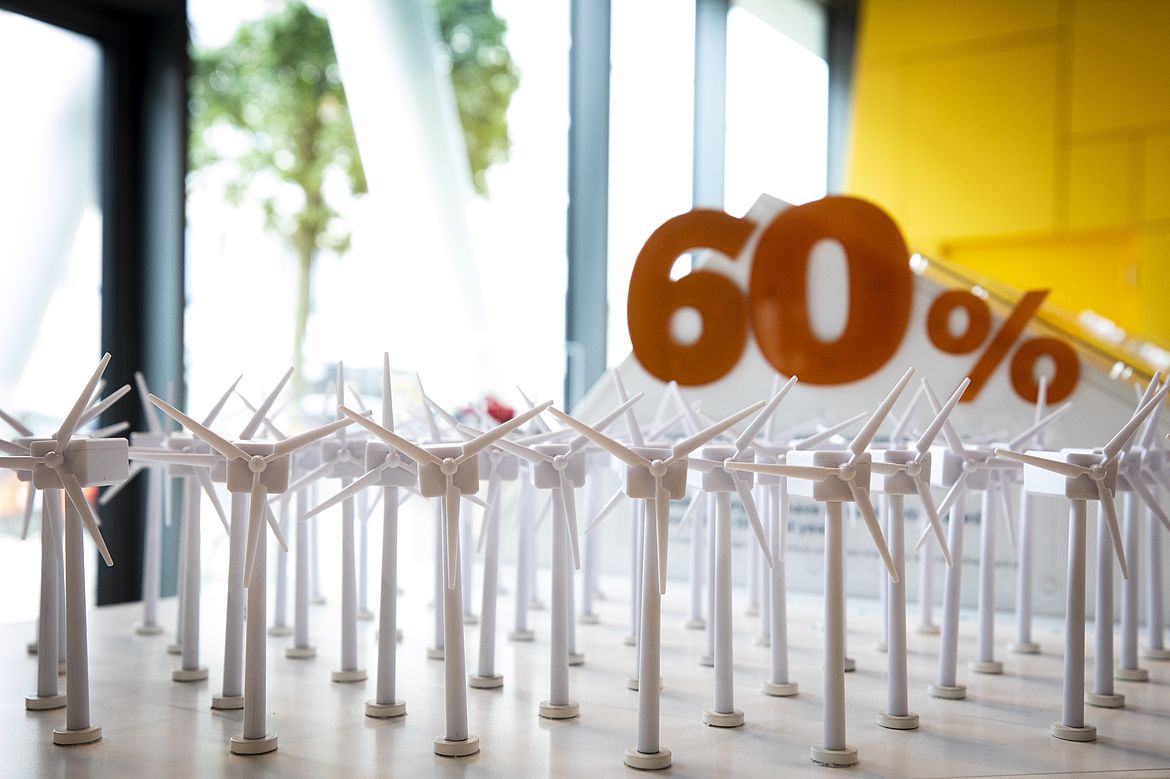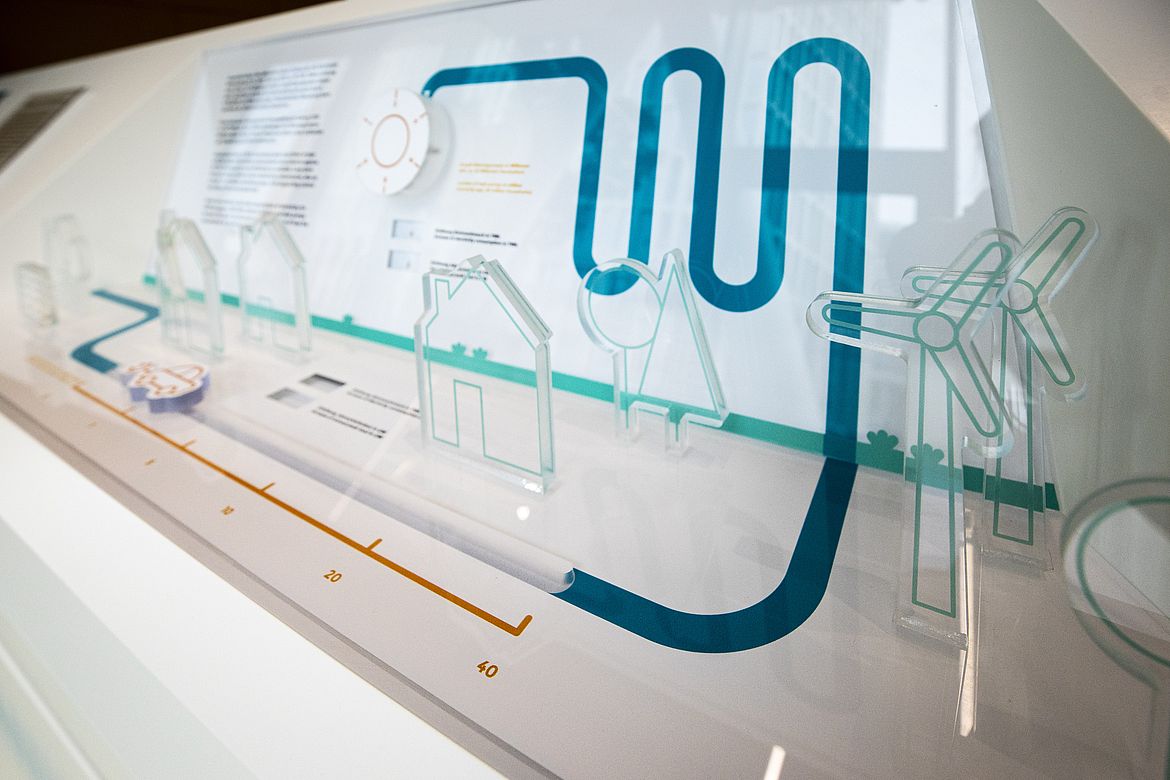Relieving the pressure on power lines through local electricity consumption
When the wind and sun push too much energy into the power systems, some power lines fall into the 'red zone'. The WindNODE flexibility platform shows how local industrial or storage units can use surplus electricity directly and so relieve the pressure on power lines in a targeted manner.
Weather forecasters had warned of Storm Siglinde coming in from the north, with "gale-force winds" (link in German) hitting the coast, reaching Beaufort Scale 9 in Mecklenburg. Fire brigades were alerted. It all started on 22 October 2018 at exactly eight o'clock in the evening.
This was the perfect storm for WindNODE's Flexibility Platform workstream.
By 8.40 p.m., the power grid operator 50Hertz was seeing the first indications that the utilisation of the lines was changing from green to orange, starting with the 220-kilovolt line from Neuenhagen to Wustermark in the north of Berlin. If the utilisation rate is over 50% of the maximum load, the signal will switch to orange, and ultimately, if it is more than 70%, it will change to red. During Storm Siglinde, it was possible to follow live on the internet (link in German) how the electricity from the wind turbines filled the lines and the indicator colours changed. At around 9:40 p.m., a high-voltage line near Rostock switched to red.
Too much electricity for too few facilities
When the wind blows strong enough, there are not enough industrial units, electricity storage units or electrical heating facilities available in north-east Germany to do anything with the huge amount of electricity available. This can happen especially at night when businesses are closed and most people are asleep. Then the power lines to the south heat up – literally. Their temperature rises, and they expand and visibly sag.
The 50Hertz high-voltage grid holds around 30,000 megawatts of wind and solar power capacity – that is 12 times the level of the lignite-fired Boxberg Power Station in Lusatia.

▶ Play
The YouTube video will only load and play after clicking. By clicking the video, you agree to Google's Privacy Policy.
If too much power is generated on the grid when it is very windy or both very windy and sunny, coal-fired power plants are shut down and then the renewable energy sources must also be taken off the grid. This is called 'feed-in management' or 'generation management'. As a result, operation of the systems remains secure. However, around 3% of potential annual green electricity generation capacity is lost. People are surprised when wind turbines are not operating when there is a lot of wind, this is because they have been taken out of service due to grid bottlenecks.
At 3.40 a.m. on the night of 22-23 October 2018, the grid operator's map in north-east Germany already showed more orange/red than green: at this point and no later than this, coal-fired power plants from Rostock to Schwarze Pumpe in Spremberg, Brandenburg, had to shut down. Some of the wind turbines on the Baltic coast, in Mecklenburg and Brandenburg, were also taken out of service.
"We had been planning for exactly that situation," says project manager Georg Meyer-Braune. The idea behind the WindNODE flexibility platform is that before individual power lines heat up, this excess green electricity should be consumed immediately on site at just the right time. And if battery storage unit operators or industrial companies control their units accordingly, there will be a financial incentive. "Our unit can use an additional megawatt of electricity between 10 and 11 p.m. tomorrow" is the kind of offer that may appear on the new WindNODE platform. These offers will then be visible to grid operators and can be used in the event of bottlenecks on the power grid. With the flexibility platform, they benefit from making operation of the grid more secure and cheaper.
Regional customers
50Hertz pushed ahead with the implementation of the flexibility platform along with the distribution system operators Stromnetz Berlin, E.DIS Netz, ENSO NETZ and WEMAG Netz. In the first two years of the project, processes were defined, the platform programmed and the products developed in coordination with potential flexibility providers.
In this context, the flexibility platform acts as a switching platform for units that can at the right time take power off the grid near particularly overloaded lines in a targeted way, because if the electricity is consumed immediately where the wind turbines generate it in those minutes or hours, then it will no longer be present on 50Hertz's particularly stressed power lines – and the wind turbines and solar units no longer have to be taken out of service.
The technical potential required to adjust the power consumption can come from different units. Various suppliers have contributed to WindNODE, such as a battery storage unit near Brandenburg an der Havel, a night storage heater near Schwerin, and a power-to-gas plant in Uckermark that produces hydrogen from electricity. Other contributors are industrial units in Berlin and cold storage depots in the south of the city that operate large-scale chillers.
A win-win situation
Along with the operators of these units, the researchers initially worked out the process for making offers available on the online flexibility platform: "With the platform, we are providing an online user/automatic interface on which offers can be posted, indicating the time frame, electrical power and price," explains Meyer-Braune. The system showed it worked in practice during the stormy night of 22 October, and again subsequently in similar weather conditions.
Everyone who depends on the power grid gains from this economically, given that suppliers can earn money by providing flexibility and grid operation costs can be reduced, ultimately benefiting all commercial and private electricity customers, i.e. virtually every single household. Furthermore, if fewer wind turbines have to be taken offline, this will benefit climate protection.
It depends on the actual impact on the grid
In practice, the use of storage units and flexible loads is even complicated for power grid operators, because when a battery storage unit draws electricity, this rarely involves just a single line. Exactly how much such a battery storage unit reduces the load on a line depends on how close it is to this line and where exactly the line is in the network of power lines. "That is why the grid operators have a model with which a factor – known as the 'sensitivity' – is specified for each individual unit," says Meyer-Braune.
One example of this is a unit near an overloaded line in north-east Germany that acts immediately on this line almost 100% of the time. It therefore has a sensitivity of 1. In contrast, the same resource in the centre of Berlin would have hardly any influence on the line – its sensitivity would be below 0.1. "We can calculate the sensitivities for any site. When operating the grid in practice, the units used would then be selected in a way that they optimally reduce the grid load," continues Meyer-Braune. Ultimately, the sensitivity factor should also be reflected in the remuneration received by the respective storage unit. This would also create an incentive to build power storage units and other units where most of the power comes from, so near wind and solar farms.
Cooperation with distribution system operators
This is where the operators of the regional systems come into play. Overloads sometimes also occur on the distribution grid. In this case, the distribution system operator can use the flexibility to reduce the load. Therefore, the regional distribution system operator has first access to the bids received on the flexibility platform. If it does not use the full capacity, the transmission system operator 50Hertz can use the remaining capacity to reduce the overloading of its own grid.
When it was first used, in 2018 during Storm Siglinde, the flexibility platform passed its first practical test within a few hours. However, for the power grid it took almost two days after 22 October for the wind to calm down enough for almost all of 50Hertz's lines to turn green again.
Since then, the flexibility platform has shown on multiple occasions that it works: the providers have posted their offers and the grid operators have used them to relieve the pressure on the lines. "The systems worked together smoothly, and we could have expanded the range of options for storage and equipment operators even further," says Meyer-Braune.
When an offer becomes an obligation
The flexibility platform was now ready to go. However, with the 2020 amendment to the Grid Expansion Acceleration Act (NABEG), lawmakers have made what was established here as a market into a mandatory requirement for many units. From October 2021 onwards, all energy resources and power storage units from 100 kW or all units with a control option will be required to make their flexibility available to grid operators to resolve bottlenecks. This also includes the battery storage units that have been registered on the WindNODE platform. As a result, units' potential for the flexibility platform, which is based on market incentives for the voluntary provision of flexibility, suddenly decreased.
Another item that contributes to free trade based on flexibility are industrial units that want to link their production to the (excess) supply of green electricity. "Unlike batteries, however, costs for overtime or production problems can arise here if electricity offtakes are postponed," says Meyer-Braune. He explains that, unlike battery storage units, these costs are very difficult to determine.
A lot of the flexibility potential that should be tapped into with WindNODE's Flexibility Platform project is now either already legally obliged to participate in the process, or there is the unsolved problem of potential false incentives when there are flexible loads. Such false incentives could arise from the fact that suppliers would have an economic incentive to exacerbate or cause situations with grid bottlenecks through their consumption or generation behavior, in order to then support the elimination of the bottleneck with the same or a different plant and earn money in the process. So far, solutions to mitigate this problem are hardly manageable in a meaningful way. Against this backdrop, it was decided that the platform would initially not continue to operate after the end of the project term.
However, the approach of creating local incentives via a platform could achieve renewed relevance in the future if the share of renewable energies in the electricity mix continues to increase significantly and/or if a solution to the problem of false incentives is found. The technical basis for the trading platform is ready for that eventuality.
3 questions for…
What did your cooperation in the WindNODE project do for you?
A large consortium with different partners can only be put together in this way as part of a research project such as WindNODE. This is the only forum in which organisations, regardless of operational processes and economic necessities, can establish such a partnership and confidential cooperation.
What will be the lasting gains?
We will possibly need such regional flexibility markets on the electricity market of the future as well as the legally required areas. The flexibility platform in WindNODE has paved the way for that. It is precisely because of this that preparations have already been made for the cooperation between transmission system and distribution system operators. You can build on that.
Where can you find the results of the project?
Experts can find the results in WindNODE documents such as the synthesis Flexibilitäten, Markt und Regulierung (Flexibilities, Market and Regulation). And for all those interested there is a visitor site in the 50Hertz atrium, an exhibition with virtual-reality modules that provides a very clear illustration of the issue of managing grid bottlenecks. The exhibition features a map showing the grid load in the 50Hertz control area and the current utilisation rate of each individual line on the transmission system. This map is also available online here.


